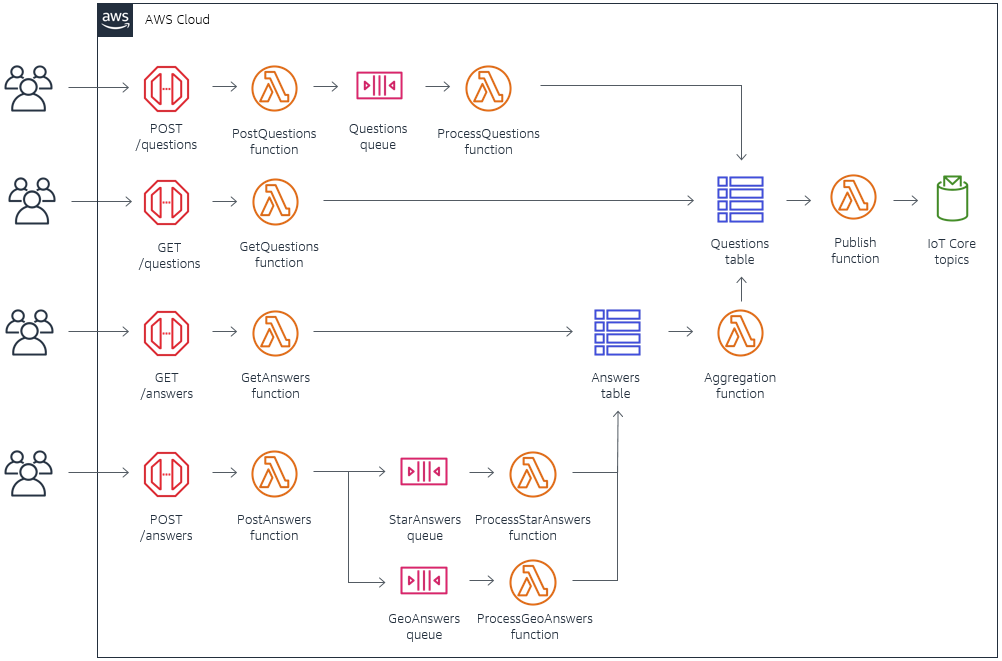AWS Compute Blog
Category: Application Services
Building a location-based, scalable, serverless web app – part 2
This post explores the backend architecture of the Ask Around Me application. I compare the cost and features in deciding between REST APIs and HTTP APIs in API Gateway. I introduce geohashing and the npm library used to handle geo-location queries in DynamoDB. And I show how you can build real-time messaging into your web applications using the publish-subscribe pattern with AWS IoT Core.
Building a location-based, scalable, serverless web app – part 1
In this post, I introduce the Ask Around Me example web application. Learn to build a serverless realtime, Vue.js web app in part 1 of this series.
Introducing the new Serverless LAMP stack
Update : You can now find the supporting GitHub repository to this series. Part 2: Scaling relational databases Part 3: Replacing the web server Part 4: Building a serverless Laravel application Part 5: The CDK construct library for the serverless LAMP stack Part 6: From MVC to serverless microservices Additional: Building PHP Lambda functions with […]
Simplifying application orchestration with AWS Step Functions and AWS SAM
Modern software applications consist of multiple components distributed across many services. AWS Step Functions lets you define serverless workflows to orchestrate these services so you can build and update your apps quickly. Step Functions manages its own state and retries when there are errors, enabling you to focus on your business logic. Now, with support […]
Best practices for organizing larger serverless applications
This blog post provides recommendations for designing and managing code repositories in larger serverless projects, and best practices for deploying releases of production systems.
Build a serverless Martian weather display with CircuitPython and AWS Lambda
Build a standalone digital weather display of Mars showing the latest images from the Mars Curiosity Rover. This project uses an Adafruit PyPortal, an open-source IoT touch display. Traditionally, a microcontroller is programmed with firmware compiled using various specific toolchains. Fortunately, the PyPortal is programmed using CircuitPython, a lightweight version of Python that works on […]
Using AWS ParallelCluster with a serverless API
Update – February 22, 2022 : We have released AWS ParallelCluster version 3. It brings with it the new ParallelCluster API and a number of improvements and changes to functionality. Check the Changelog, Instructions for Moving from 2.x to 3.x, or the AWS ParallelCluster documentation for more. This post is contributed by Dario La Porta, […]
Creating a scalable serverless import process for Amazon DynamoDB
Amazon DynamoDB is a web-scale NoSQL database designed to provide low latency access to data. It’s well suited to many serverless applications as a primary data store, and fits into many common enterprise architectures. In this post, I show how you can import large amounts of data to DynamoDB using a serverless approach. This uses […]
Building an automated knowledge repo with Amazon EventBridge and Zendesk
Zendesk Guide is a smart knowledge base that helps customers harness the power of institutional knowledge. It enables users to build a customizable help center and customer portal. This post shows how to implement a bidirectional event orchestration pattern between AWS services and an Amazon EventBridge third-party integration partner. This example uses support ticket events […]
Automating scalable business workflows using minimal code
In this blog post, I show how to use a serverless application to build and manage enterprise workflows at scale. This minimal-code solution is highly scalable and flexible, and can be modified easily to meet your needs.









